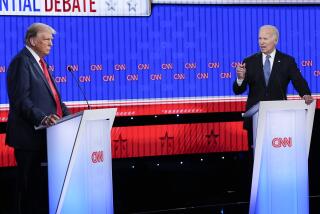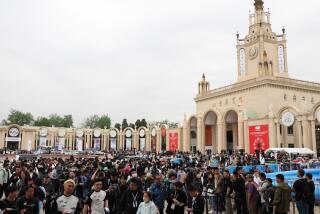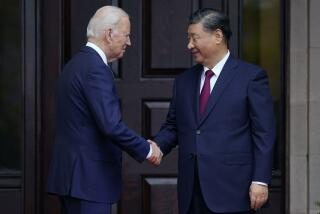Obama makes progress on climate change, the bright spot in his China policy
Reporting from HANGZHOU, CHINA — President Obama, often frustrated in his efforts to contain China’s regional power, advance human rights and open markets, has settled for progress elsewhere in relations between the world’s leading economies: tackling climate change.
In an announcement Saturday that virtually no one predicted when Obama began to draw up his foreign policy goals after taking office in 2009, he and Chinese President Xi Jinping officially committed their nations to a landmark global climate agreement years ahead of schedule.
For the record:
1:06 p.m. Aug. 22, 2019An earlier version of this article incorrectly spelled China analyst Dean Cheng’s last name as Chen.
And Obama and Xi, despite their many other differences, cemented their leadership crafting tough environmental standards and prodding others to follow.
“Just as I believe the Paris agreement will ultimately prove to be a turning point for our planet, I believe that history will judge today’s effort as pivotal,” Obama said in a ceremony with Xi ahead of the Group of 20 summit to make the ratification formal. “Today we are moving the world significantly closer to the goal that we have set.”
Xi said he hopes other countries will step up their timelines for committing to the Paris accord, following the example of China. “When the old path no longer takes us far, we should make use of new methods,” Xi said. “China is a responsible developing country and acts as a participant in global climate change efforts.”
Joint progress in the fight against climate change was far from certain at the beginning of the Obama presidency, and the White House had not expected this breakthrough amid other failed attempts at cooperation.
“For decades previously, it was as if China and the United States were the captains of two opposing teams in a match” over greenhouse gases, said Brian Deese, a key Obama advisor and negotiator in the climate talks. “The president was always optimistic,” he said, but “clear-eyed.”
When he crafted his China policy, Obama sought out issues on which the U.S. could cooperate with the Chinese, as well as areas in which the two nations would compete.
The strategy was part of Obama’s plan to shift U.S. focus from the Middle East to East Asia, a strategy often termed as his “Asia pivot.”
The approach was predicated on nurturing strong lines of communications between Obama and Xi, who took office in 2013.
The effort began in earnest with a summit that year between Obama and Xi at the Sunnylands presidential retreat in Rancho Mirage, a meeting that gave Obama his first real glimpse into the mind of the Chinese leader.
Xi used that meeting to propose a “new type of great power relations” between the two countries.
Xi’s phrase revealed how China views its resurgent global role, as the White House saw it, just as Obama’s refusal to echo it demonstrated his trepidation.
The two leaders kept talking, meeting eight times over the last 3½ years and sanctioning scores of bilateral talks between their governments.
At the same time, though, Xi began pushing a much more aggressive stance in Asia that by its nature would limit the influence of the West.
China provoked its neighbors with confrontations in the South China Sea, an area claimed by other countries in the region, and has moved to build a military facility on an artificial island there.
“From the Chinese side, there’s much less of a perception that they need anything out of the U.S.,” said Arthur Kroeber, managing director of the Beijing-based research firm Gavekal Dragonomics. “So that means, conversely, the U.S. has less leverage to get things it wants.”
That has become plain in other ways too. China refused to participate in the Trans-Pacific Partnership, the signature trade pact Obama is still trying to pass.
American businesses complain of greater restrictions and murky laws that make it harder to compete in China.
China also passed a law requiring greater scrutiny of foreign nonprofit organizations and their local partners, and launched a campaign against so-called Western values.
The country has clashed with the U.S. over investment rules and currency exchange rate policy. Tensions remain high over Chinese breaches of American cybersecurity systems.
And, in a striking rebuke of free speech, the Chinese government last year rounded up more than 300 lawyers and human rights advocates.
“China is a richer, more diverse and more self-confident country than it used to be,” Kroeber said. “It can be more assertive going after what it wants. And there’s not much anyone else can do to change that.”
That made climate change an unlikely issue where the two superpowers might cooperate.
But a popular Chinese revolt may have achieved what diplomacy alone could not.
After a wave of choking air pollution in Beijing inspired a sharp backlash from the Chinese people in 2011, the country began to promote investments in renewable energy and stepped up plans to set up a carbon trade market to discourage pollution.
Critics of Obama’s foreign policy have asked whether the U.S. should be so deeply involved in collaborative projects with the communist nation.
And human rights advocates continue to question whether the administration is imposing any real penalties on China for imprisoning and killing dissidents.
Others say there’s not enough credible information to determine whether gains from the climate agreements are all that significant.
“Do we believe that the Chinese are actually operating under that accord?” asked Dean Cheng, a China analyst at the conservative Heritage Foundation think tank. “Do we really see them as cutting back, when they are now the biggest global greenhouse emitter?”
But Obama advisors point to the climate agreement as validation of the president’s approach.
They say Obama is under no illusions about why Chinese officials have come to the table to talk about any of the issues on his agenda. The Chinese concluded, for example, that it was in their interest to not join the trade deal.
The climate agreement stands out because the Chinese government did its own analysis and determined that cooperation suited the nation. In that sense, said Deese, it’s an example of how Obama thinks about using American power “as a force for good.”
Obama’s approach has always been to identify areas of mutual interest and then try to work something out, Deese said.
“We have been very clear throughout this whole process that where there are areas where we can work together, we’re going to seek to do that, and seek to leverage that cooperation as much as we can,” Deese said. “But there are lots of areas where we have disagreements, and we’re going to be very clear and very resolute about those disagreements as well.”
Times staff writer Jonathan Kaiman and special correspondent Jessica Meyers in Beijing contributed to this report.
Follow @cparsons for news about the White House.
ALSO
How a burial ceremony in Kabul turned deadly
U.S. and China ratify sweeping climate deal and urge other nations to follow their lead
More to Read
Sign up for Essential California
The most important California stories and recommendations in your inbox every morning.
You may occasionally receive promotional content from the Los Angeles Times.











